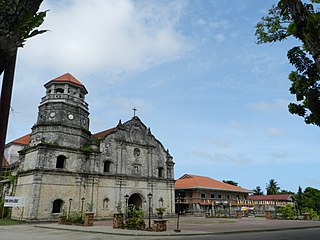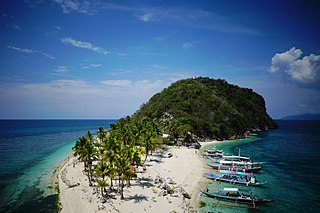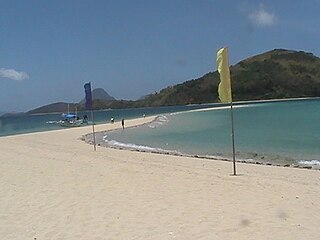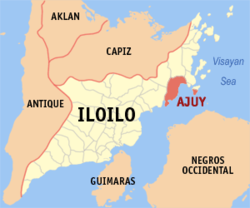
Pototan, is a 1st class municipality in the province of Iloilo, Philippines. According to the 2020 census, it has a population of 78,298 people.

Tigbauan, officially the Municipality of Tigbauan, is a 2nd class municipality in the province of Iloilo, Philippines. According to the 2020 census, it has a population of 65,245 people.

Buenavista, officially the Municipality of Buenavista, is a 2nd class municipality and the largest settlement in the province of Guimaras, Philippines. According to the 2020 census, it has a population of 52,899 people.

Jordan, officially the Municipality of Jordan, is a 3rd class municipality and capital of the province of Guimaras, Philippines. The name itself should not to be confused with the country of Jordan, which had its capital at Amman. According to the 2020 census, it has a population of 39,566 people, making it the third largest settlement in the province.

Pontevedra, officially the Municipality of Pontevedra, is a 3rd class municipality in the province of Negros Occidental, Philippines. According to the 2020 census, it has a population of 54,502 people.

Culasi, officially the Municipality of Culasi, is a 3rd class municipality in the province of Antique, Philippines. According to the 2020 census, it has a population of 44,494 people. Making it fourth most populous municipality in the province of Antique and third largest municipality in terms of land area, with a total area of 228.56 square kilometers.

Panay, officially the Municipality of Panay, is a 3rd class municipality in the province of Capiz, Philippines. According to the 2020 census, it has a population of 48,890 people.

Balasan, officially the Municipality of Balasan, is a 4th class municipality in the province of Iloilo, Philippines. According to the 2020 census, it has a population of 35,064 people.

Barotac Viejo, officially the Municipality of Barotac Viejo, is a 3rd class municipality in the province of Iloilo, Philippines. According to the 2020 census, it has a population of 48,614 people.

Calinog, officially the Municipality of Calinog, is a 1st class municipality in the province of Iloilo, Philippines. According to the 2020 census, it has a population of 62,853 people.

Carles, officially the Municipality of Carles, is a 2nd class municipality in the province of Iloilo, Philippines. According to the 2020 census, it has a population of 72,637 people.

Concepcion, officially the Municipality of Concepcion, is a 3rd class municipality in the province of Iloilo, Philippines. According to the 2020 census, it has a population of 44,633 people.

Dueñas, officially the Municipality of Dueñas, is a 4th class municipality in the province of Iloilo, Philippines. According to the 2020 census, it has a population of 34,597 people.

Estancia, officially the Municipality of Estancia, is a 2nd class municipality in the province of Iloilo, Philippines. According to the 2020 census, it has a population of 53,200 people.

Lambunao, officially the Municipality of Lambunao, is a 1st class municipality in the province of Iloilo, Philippines. According to the 2020 census, it has a population of 81,236 people.

Pavia, officially the Municipality of Pavia, is a 1st class municipality in the province of Iloilo, Philippines. According to the 2020 census, it has a population of 70,388 people.

Oton, officially the Municipality of Oton, is a 1st class municipality in the province of Iloilo, Philippines. According to the 2020 census, it has a population of 98,509 people making it as the most populous town in the province and the entire Panay island.

San Rafael, officially the Municipality of San Rafael, is a 5th class municipality in the province of Iloilo, Philippines. According to the 2020 census, it has a population of 17,795 people.

San Miguel, officially the Municipality of San Miguel, is a 4th class municipality in the province of Iloilo, Philippines. According to the 2020 census, it has a population of 30,115 people.

Sara, officially the Municipality of Sara, is a 2nd class municipality in the province of Iloilo, Philippines. According to the 2020 census, it has a population of 54,637 people.
























